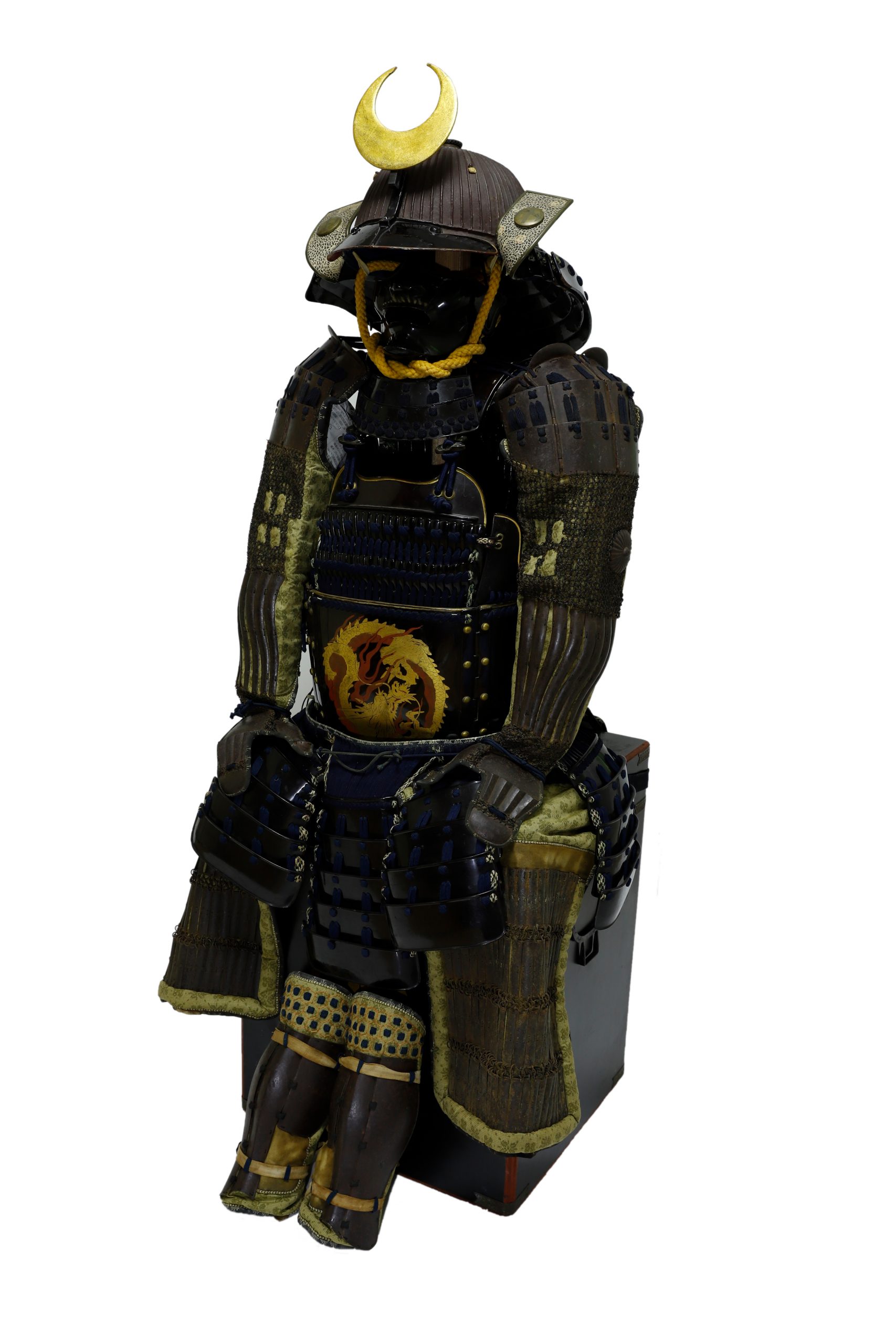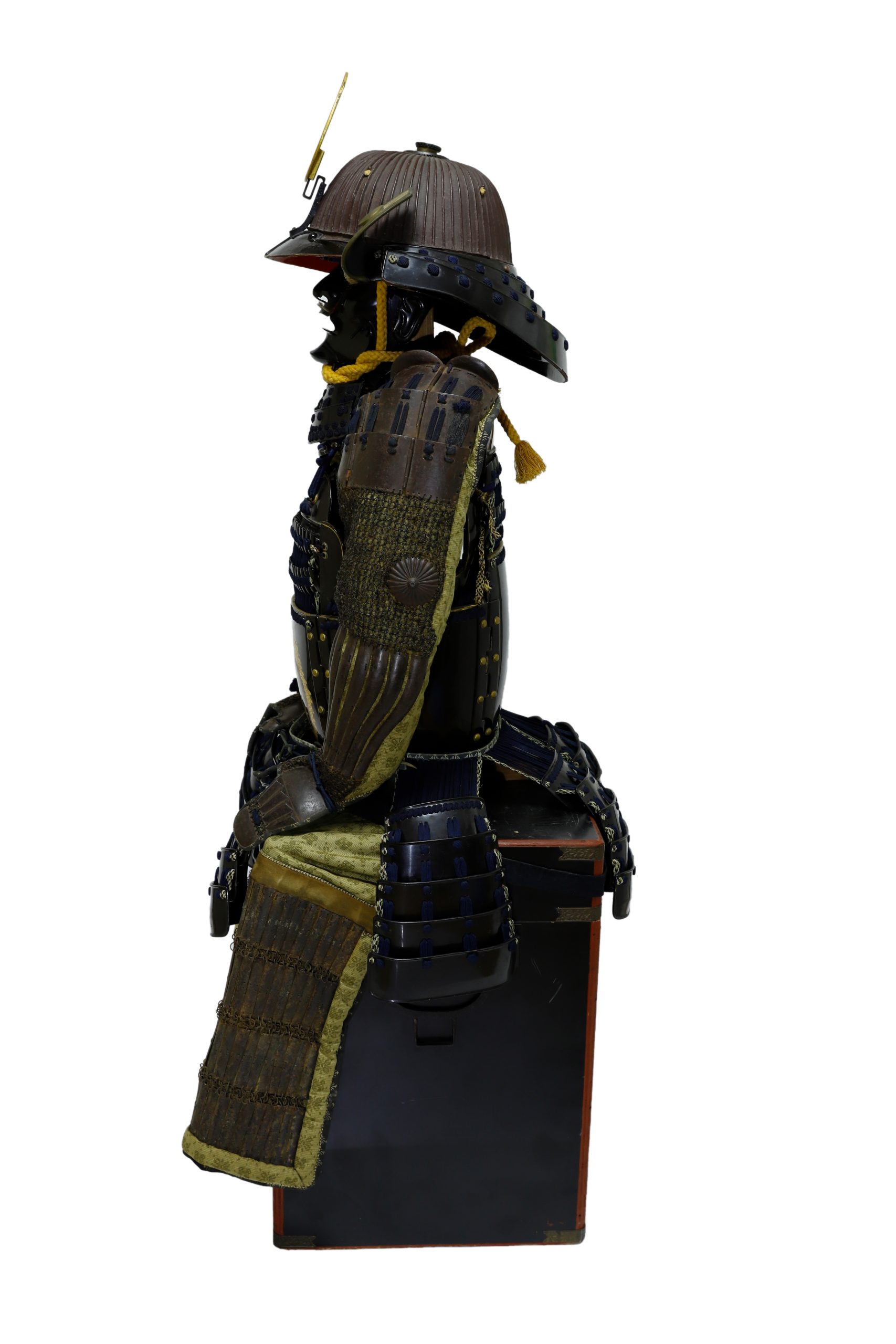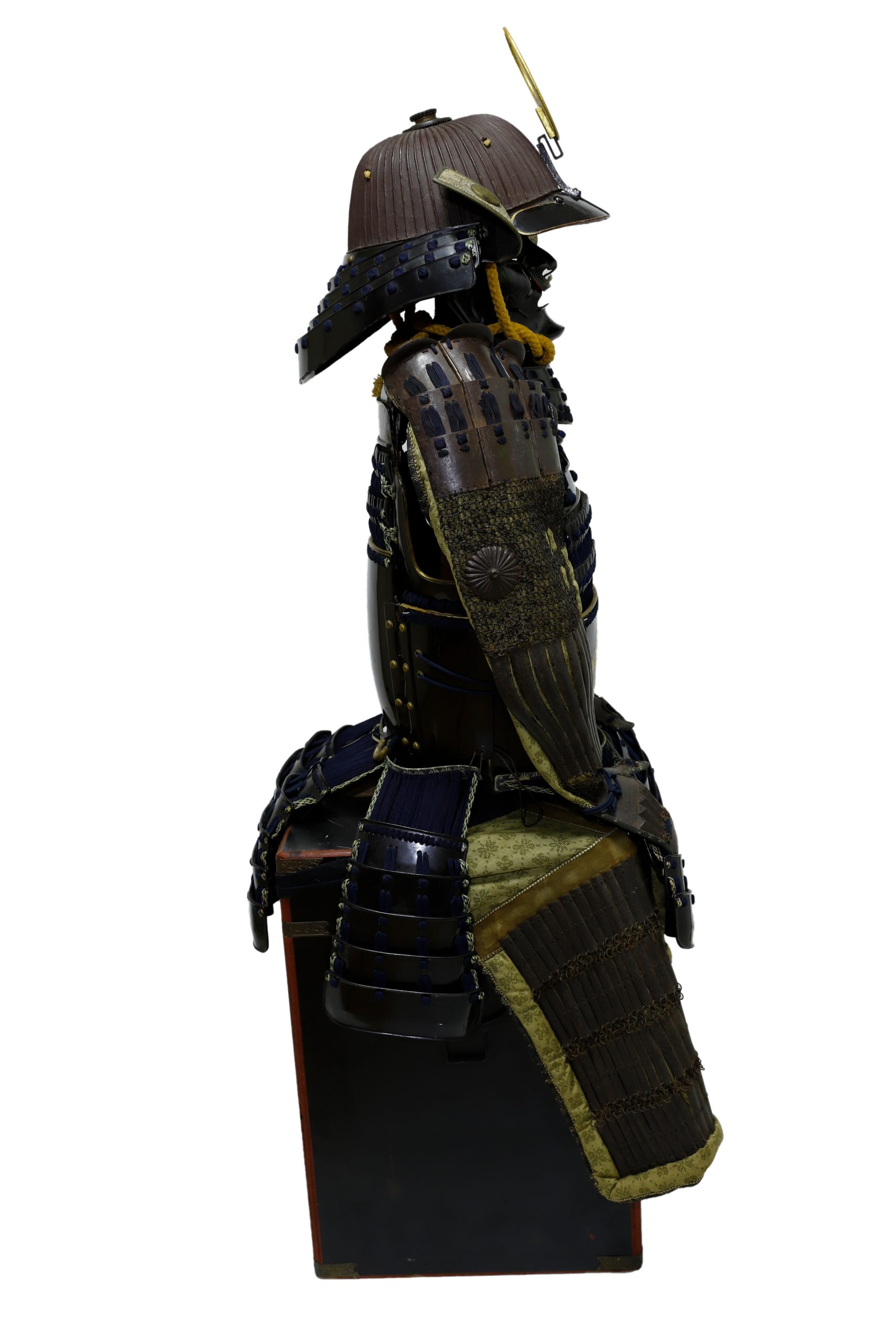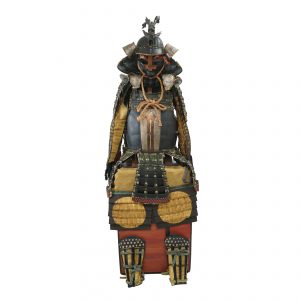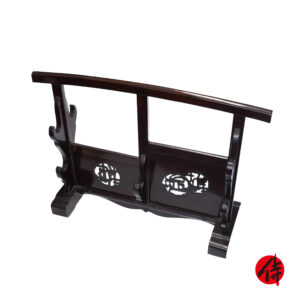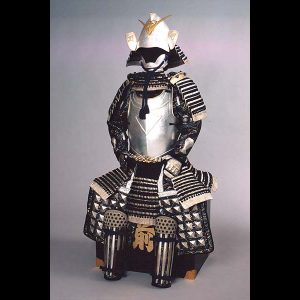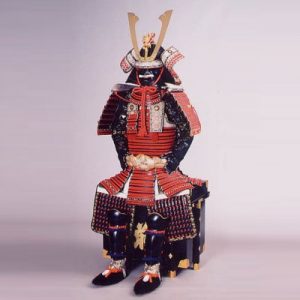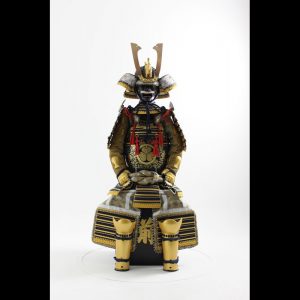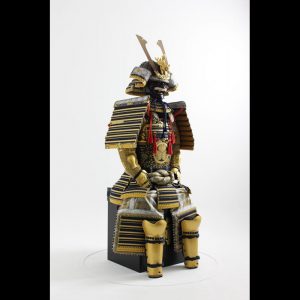Antique Mid Edo Period Samurai Armor (Helmet Signed by Myochin) with Tokubetsu Kicho Shiryo Certificate
Period: middle of the Edo Period
appraised by The Association for the Research and Preservation of Japanese Helmets and Armor

Kabuto (helmet)
■Helmet bowl: Tetsusabiji Kabuto (helmet)
The surface is coated with lacquer whose color resembles the iron rust (Tetsusabi)
■Shikoro(side neck guard):
Iron plates laced with navy blue
■Menpo (face guard): iron mask with mustache made of horse tail hair
This type of Menpo (faceguard) is called Retsusei Menpo (烈勢面頬). It represents the angry face to intimidate enemies. It also has mustache made of horsetail fur.
■Maedate (front decoration): Mikaduki
The Maetate (前立, front decoration) of this helmet imitates a Mikaduki (三日月, crescent moon). We imagine that its golden color caught people’s eyes on the battlefields. According to a theory, the crescent moon design of the Maetate comes from the Myouken (妙見) belief. This religion was born in India. It was mixed with the Polestar belief and was brought to Japan from the Continent. In the Myouken belief, the moon and stars were the symbols of faith. The Myouken Bosatsu (妙見菩薩, 菩薩 means Bodhisattva) fulfills all wishes such as fertility of rich harvest, peace, the prosperity of the clan, healing of illness, longevity, success in business, traffic safety, academic achievement, marriage, etcetera. Understandably, the moon motif for the Maetate was popular among Samurais. The former owner of this armor might have had shown his faith wearing this helmet.
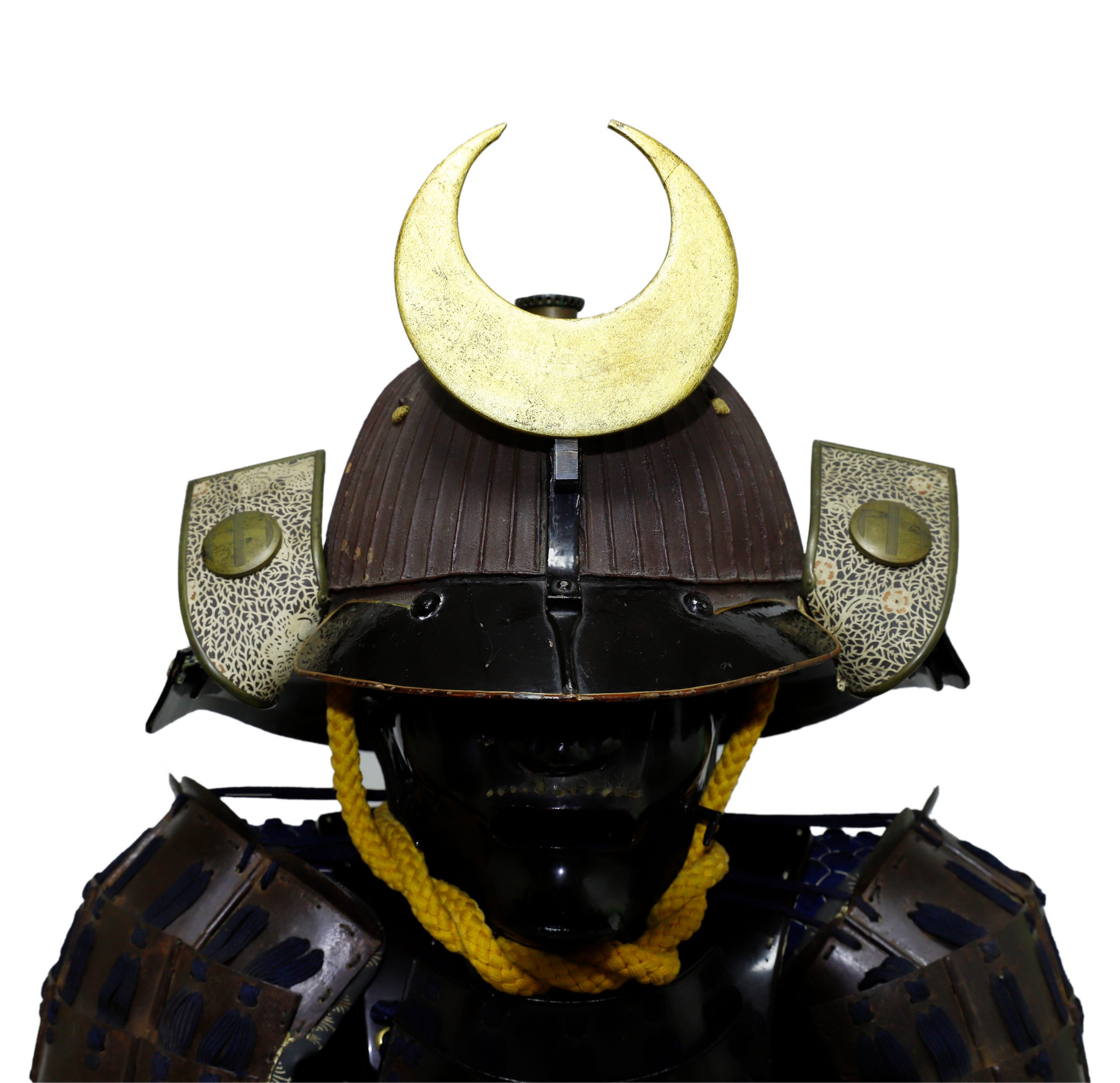
■Fukikaeshi: family crest; Hikiryou Mon
The family crest is designed on the Fukikaeshi (吹き返し) part. This mark is categorized as the Hikiryou (引両) pattern; it is a simple design with two horizontal lines in the circle. In ancient times, Samurai families had a custom marking the flag with a god’s name and drawing a black bar below it. By doing this, they prayed to Shinto spirits; their luck in a war would last for a long time. However, the custom was gradually changed its manner, and only the black line has remained. Because of this history, there is a close connection between Hikiryou-Mon and Samurai families. It is also said that these lines represent dragons. As the dragon pattern has been treated as an auspicious design, it is possible to compare lines to this sacred beast. Ashikaga Takauji, who opened the Muromachi government, used this Hikiryou-Mon for his family crest.
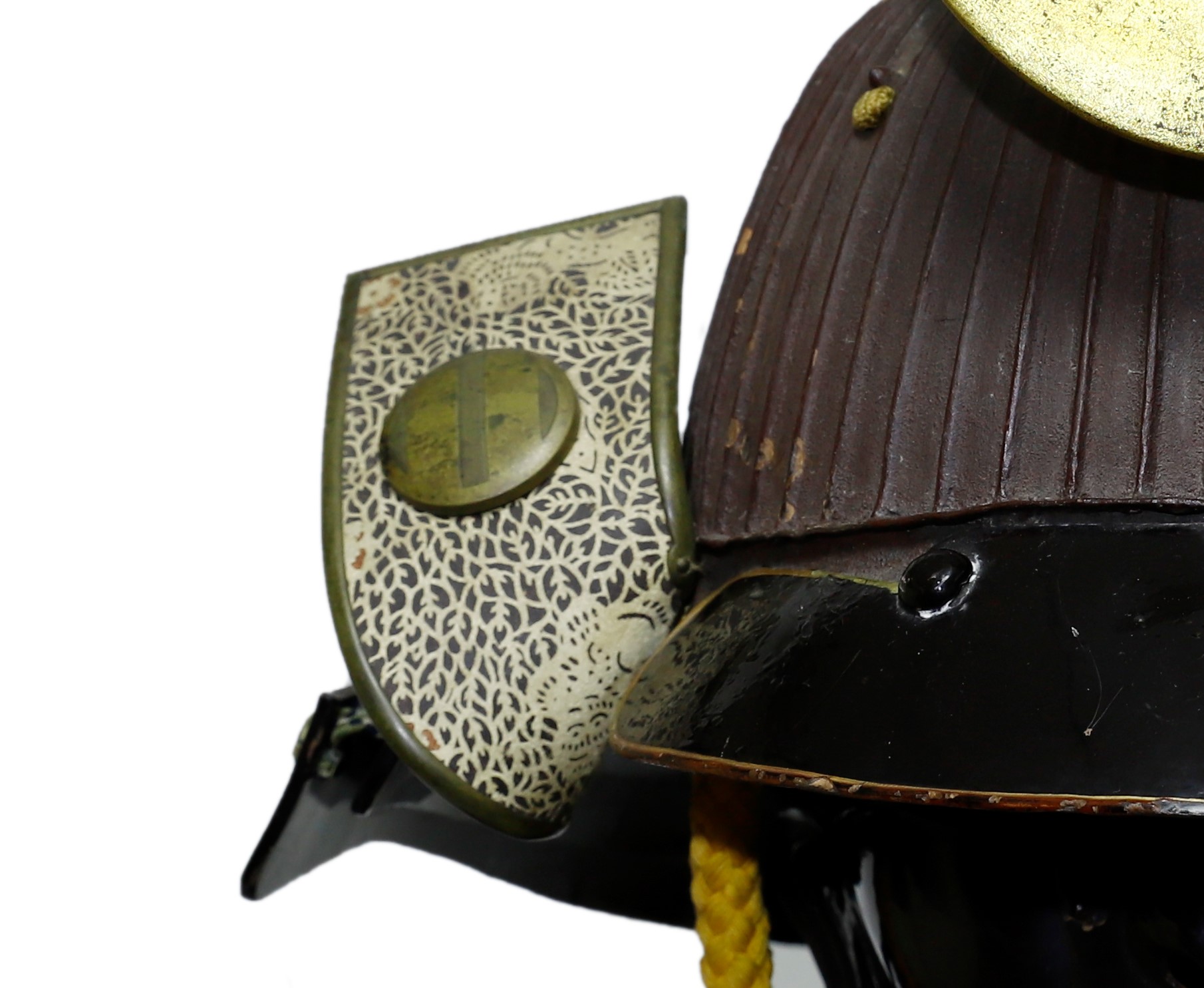
■ Signature: Myochin Muneichi (明珍宗一)
There is a signature of Myochin Muneichi inside the helmet. Myochin is the name of a famous armor-making school that has been continuing for generations since the Heian period. Today, 25th master of Myochin still produces Samurai armor.

Armor
■Do (cuirass): Gomai Do
Gomai Do is a kind of cuirass for Tousei Gusoku (developed armor style). Gomai Do was named after the fact that Gomai means five plates, and Do means torso in Japanese. This part can be separated into five pieces and connected with a hinge. Typically, the hinge is located on the left side, and you can tighten this cuirass on the right side.
■ Decoration on body armor:
■Sode (shoulder guards): Tetsusabiji iron Sode laced with navy blue thread.
■Kusazuri: lacquered iron Kusazuri laced with navy blue thread
Kusazuri is a skirt of plates attached to the cuirass

A giant dragon is designed for the body part. It is colored with bright gold and red. This dragon twists its elongated body like a circle and has a sharp and robust gaze as if watching at the top. It is said that Samurais once tried to show their dignity by wearing the characteristic designed-helmets. So, this dragon design might have been chosen with the same intention.
Initially, the dragon is an imaginary creature found in ancient traditions or myths. Furthermore, it is regarded as a symbolic beast of auspicious signs. Its body is likened to nine animals: antlers are deer, the head is a camel, eyes are demons, the neck is a snake, belly is the Mizuchi (蛟, mythical animal in Japan which looks like a snake and have a horn and four legs), scales are fish, claws are falcons, palms are tigers, and ears are cows. It was thought that the dragon would reign at the top of all animals because of its odd-looking appearance.

Small parts
■Kote (armored sleeves): intricate iron chain mail with silk

■Haidate (thigh protection): Haidate is a shin guard

■Suneate (shin guard): lacquered iron Suneate
The Kikkou (亀甲, turtle’s shell) pattern is used for the cloth of leg guard. It is a continuous geometric pattern connecting regular hexagons up and down. A theory says that this design was brought from China and the Korean Peninsula in the Asuka (592-710), Nara period (710-794). A proverb says turtles live a long life; therefore, turtle and turtle’s shell pattern represent longevity. In addition, as this continuous hexagonal pattern does not get out of its shape, it is said people wished for eternal prosperity by using this design.

■Kacchu-Hitsu (armor box): wooden armor box
A family crest is designed on this armor’s box. This mark is categorized as the Maru-ni Omodaka (丸に沢瀉) pattern. This plant’s Japanese name Omodaka (沢瀉) is compared to another ward Omodaka (面高), which means save face/ keep honor. Also, as its leaf looks similar to arrowhead (arrow was once primary weapon for Samurais), this plant was called the Kachi-Gusa (勝ち草, winning leaf). Based on these things, the Omodaka motif was appreciated among Samurais, and they used it for their family crests.

Certification: Tokubetsu Kicho Shiryo Certificate (1921)
The certificate will be issued by The Association for the Research and Preservation of Japanese Helmets and Armor, which is the most trusted Japanese armor appraiser in Japan. Tokubetsu Kicho Shiryo means an especially precious cultural article. It is ranked as the third highest of five rankings.
This armor was authenticated on October 10th 2021 as Tokubetsu Kicho Shiryo and the paper will mention the armor was made in the mid Edo period. We are expecting to receive this authentication paper by the end of December or early January.

An English translation of the certificate is available on request. We won’t charge any additional fee.
【About us】
Samurai Museum is located in Tokyo, Japan, exhibiting antique artifacts related to the Samurai history. Samurai Museum Shop is the place for those who are interested in Japanese culture and craftsmanship. We deal with antique Samurai swords/armor, traditional crafts made in Japan and so on.
【Antique Japanese Armor and Export process】
After receiving the full payment from you, we will apply for its export permit from the agency for Cultural Affairs to legally export the antique Samurai armor to other countries. It normally takes around 2-4 weeks to receive this permit. And we would like you to expect at least 1-1.5 months for your order to arrive at your given address after you ordered.
【Payment method】
We accept payment through Stripe (Credit card), PayPal, Apple Pay or ChromePay, all of which are secure payment methods. Also, you don’t need to make an account on Stripe for the checkout. If you prefer other payment method, please contact us. You may either pay in JPY, USD, AUD, CAD, EUR, CHF or GBP. The price is set in Japanese Yen. Prices in other currencies are automatically calculated based on the latest exchange rate.

【Shipping duration】
We normally ship via EMS (Express Mail Service) provided by Japan Post. It usually takes at least 5-14 days to deliver the package after you place an order. We offer Free International Shipping as long as we can ship your order by EMS. If you prefer other shipping carriers, please contact us.
We will inform you of the order’s tracking number via email. Please make sure you fill out your valid email address correctly.
*Please keep in mind that due to the spread of COVID-19, there might be possible delays in delivery. If you like to make sure if EMS shipping is available to your country, please contact us.

【How to make sure the condition】
Please keep in mind that what you are going to purchase is an antique item. We uploaded high resolution photos for you to check its condition thoroughly. If you like to see more photos with different angles, please feel free to contact us. We will be happy to send them to you so that you can make informed decision. It is essential for us to know that you are happy with your choice of a sword. and we are prepared to use the best of our ability to serve you.
【How To Contact Us】
Please contact us through email, Facebook Messenger or Live Chat if you have any questions. You can find each icon on the right side of the website. Please click one of them to reach us. We will reply to you within 1-2 business days.
【How To Preserve Antique Samurai Armor】
Dryness, humidity, and bad ventilation might deteriorate the condition of antique Samurai armor. The best temperature to preserve Samurai armor is around 20℃ in Celsius, and humidity should be about 60%. Direct sunlight should be avoided. We recommend storing armors in a room with good ventilation. If you like to display them outside the boxes for a prolonged time, we suggest using a glass case in order for dust not to be accumulated easily. In case you don’t use a glass case, please make sure to regularly dust off from the armor by using a soft brush made of delicate cloth or brush for painting.
If you like to know more about the preservation of this armor, please feel free to contact us.

